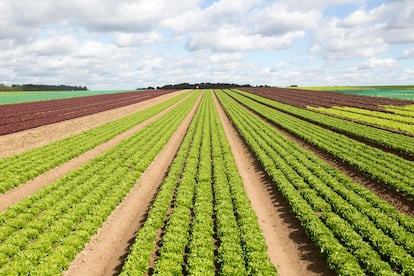Extreme weather and epidemics: How 75 people were hospitalized after eating contaminated lettuce
A British study into a food-borne pathogen outbreak linked to heavy rains highlights the risk climate change poses to public health

Health alerts were raised in the United Kingdom in early September 2022. In just 72 hours, between September 5 and 7, the U.K. Health Security Agency (UKHSA) confirmed 73 cases of food poisoning caused by Shiga toxin-producing Escherichia coli O157, a pathogen of animal origin that requires hospitalization in about 30% of patients and is fatal in some children. Given that the country typically records no more than 15 cases per month and that suspected samples continued to arrive in the hundreds, the British authorities declared a national outbreak on September 7, and created a working group, called the Incident Management Team (IMT), which was made up of members from different agencies on heath and food safety.
The IMT’s efforts soon revealed that the cause of the outbreak was lettuce contaminated by E. coli. “But we still did not know how it had been contaminated. Further investigations were carried out to determine whether climatic factors had played a role. Using new techniques and analysis, including meteorological data, information on land use and sheep farms, we were able to better understand the events that probably led to the outbreak,” a UKHSA spokesperson tells EL PAÍS via email.
The result of this work is an article that has been published in the latest issue of the scientific journal Eurosurveillance. The study provides new evidence of the enormous impact that climatic factors have on public health and the challenges posed by increasingly frequent extreme weather events. Key to the research is the idea of the “cascading risk pathways” associated with climate change. In other words, how an extreme episode of rainfall (or any other phenomenon) sets in motion “a sequence of secondary, causally connected events” that end up triggering a serious public health problem.
Stagnant water and flooding
“Investigations determined how a series of adverse weather events in July and August 2022 likely led to crop contamination. The prolonged periods of extremely dry weather and heavy rainfall that followed likely contributed to the amplification and spread of bacteria through the environment, with standing water and flooding ultimately leading to crop contamination,” state UKHSA.
Isidro Mirón, professor at the Faculty of Health Sciences of the Rey Juan Carlos University in Madrid and one of the leading Spanish experts on the subject, praises the research. “It is an interesting work that links a major outbreak of disease with the consumption of contaminated lettuce. Climate change increases the risk of food-borne and water-borne diseases because extreme weather events such as torrential rains and rising temperatures are becoming more frequent,” he argues.
The new study precisely describes the chain of events that led to the outbreak in the U.K. But as climate change is a global phenomenon, every country is at risk of such episodes. In the Spain town of Tarazon, for example, more than 500 people fell ill after drinking tap water contaminated by the protozoan of the genus Cryptosporidium, another pathogen of animal origin. Investigations revealed that the most likely source of the outbreak was livestock farms located upstream of the Quiles River in the province of Soria, arguing that heavy rains had carried the causative agent of the disease into the river and contaminated drinking water system, when the river overflowed.
“The Eurosurveillance article is fantastic in the way it manages to document the clone involved in the outbreak and its causal relationship in this case with contaminated lettuce, which is usually very difficult to achieve,” says Luis Buzón, the spokesperson for the Spanish Society of Infectious Diseases and Clinical Microbiology (SEIMC).
The expert explains that Escherichia coli “is a very common bacteria, for example, it is the most frequent cause of urinary tract infection in women.” He continues: “What is special about this clone, O157, is that it produces a toxin called Shiga. It usually colonizes the digestive system of cattle and sheep and, if it reaches humans, it produces infections that can develop into serious conditions, in particular hemolytic uremic syndrome (HUS), which causes complications such as hemolytic anemia and acute kidney damage.”
According to the study data, between August and October 2022, British health authorities confirmed 259 cases linked to the outbreak. The cases were detected across nearly the entire country due to the wide commercial distribution of the contaminated lettuce. The most commonly reported symptoms were diarrhea (92%), abdominal pain (87%) and blood in stools (65%). A total of 75 people needed to be hospitalized. No patient, however, developed hemolytic uremic syndrome and no deaths were recorded. Large studies in the scientific literature indicate, however, that almost 5% of people infected with Escherichia coli O157 develop HUS — a much higher percentage in children — and that about 0.5% die.
Luis Buzón is more cautious when it comes to linking the outbreak with climate change. “It is a clone that we have known about for decades. It is true that in this case it is related to an episode of torrential rains, but it is more of a hypothesis that the case is due to climate change,” he says. Isidro Mirón, for his part, points out that he does not “like to link specific outbreaks with climate change,” although he insists that it is “evident” that increasingly frequent weather phenomena is increasing the risk of this kind of public health problem.
The UKHSA argues that it is important to determine why an outbreak occurs: “It can help us prevent future episodes. As we expect more intense rainfall due to climate change, the techniques used in this research could be applied to future episodes to complement traditional epidemiology and food chain investigation methods, as well as in risk assessments to help farmers grow safe products for human consumption.”
In the conclusions of the article — of which UKHSA internist Neil Cunningham is the first author — the researchers admit the difficulty of dealing with such outbreaks: “Fresh produce contamination events are typically transient, and the resulting outbreaks often end before intervention measures can be implemented. Nevertheless, there is increasing evidence to show that outbreaks linked to fresh produce and caused by the same whole genome sequenced defined strain of bacteria can re-occur year after year.”
“Therefore, it is important to resolve the root cause of such outbreaks, make recommendations and implement preventative and control measures,” the study continues. The researchers argue that “proactive utilization of real-time weather monitoring data could be used [...] to identify farms experiencing adverse weather events that could result in amplification of risk.”
The researchers conclude: “Therefore, we recommend more routine use of weather, animal and land data incorporated into outbreak investigation approaches to correlate heavy rainfall patterns and other unusual weather events with outbreaks and incidence of food-borne gastrointestinal disease, to inform the evidence base, and to better understand the impact of climate change on public health.”
Sign up for our weekly newsletter to get more English-language news coverage from EL PAÍS USA Edition
Tu suscripción se está usando en otro dispositivo
¿Quieres añadir otro usuario a tu suscripción?
Si continúas leyendo en este dispositivo, no se podrá leer en el otro.
FlechaTu suscripción se está usando en otro dispositivo y solo puedes acceder a EL PAÍS desde un dispositivo a la vez.
Si quieres compartir tu cuenta, cambia tu suscripción a la modalidad Premium, así podrás añadir otro usuario. Cada uno accederá con su propia cuenta de email, lo que os permitirá personalizar vuestra experiencia en EL PAÍS.
¿Tienes una suscripción de empresa? Accede aquí para contratar más cuentas.
En el caso de no saber quién está usando tu cuenta, te recomendamos cambiar tu contraseña aquí.
Si decides continuar compartiendo tu cuenta, este mensaje se mostrará en tu dispositivo y en el de la otra persona que está usando tu cuenta de forma indefinida, afectando a tu experiencia de lectura. Puedes consultar aquí los términos y condiciones de la suscripción digital.
More information
Archived In
Últimas noticias
Most viewed
- Sinaloa Cartel war is taking its toll on Los Chapitos
- Oona Chaplin: ‘I told James Cameron that I was living in a treehouse and starting a permaculture project with a friend’
- Reinhard Genzel, Nobel laureate in physics: ‘One-minute videos will never give you the truth’
- Why the price of coffee has skyrocketed: from Brazilian plantations to specialty coffee houses
- Silver prices are going crazy: This is what’s fueling the rally










































